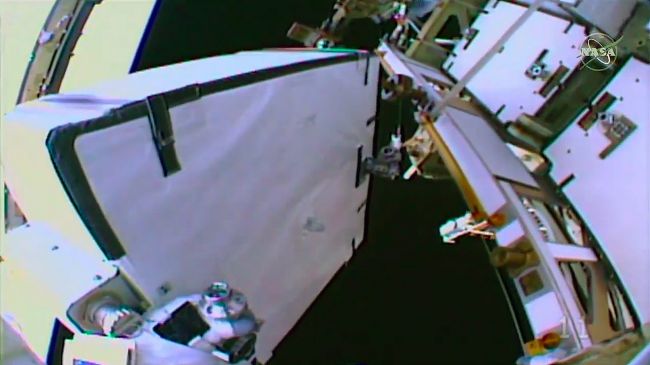
Two NASA astronauts worked to replace batteries outside of the International Space Station, completing the first in a series of five planned spacewalks devoted to upgrading the orbiting laboratory’s power system.
Expedition 61 flight engineers Christina Koch and Andrew Morgan worked in the vacuum of space for 7 hours and 1 minute on Sunday (Oct. 6). Their extravehicular activity (EVA, or spacewalk) began at 7:39 a.m. EDT (1139 GMT) and ended at 2:40 p.m. EDT (1840 GMT).
Continuing a process that began with an initial set of battery replacements in January 2017, Koch and Morgan ventured to the far left, or port, side of the space station’s backbone truss to work on some of the outpost’s older power storage units.
“Oh my goodness, it is gorgeous,” said Morgan early in the spacewalk, reacting to the sun rising as he peered off the side of the station at Earth below. “This is pretty awesome.”
The space station is powered by eight large solar array wings, four on each side of the truss. The arrays feed electricity to the station’s systems when in sunlight and charge a bank of four large batteries mounted at their base for when the station passes into the shadow of Earth.
Koch and Morgan replaced two of the old nickel-hydrogen batteries with two new lithium-ion batteries that were delivered to the space station on board Japan’s H-II Transfer Vehicle-8 (HTV-8) that arrived on Sept. 28. Each of the more powerful lithium-ion batteries can hold the charge of two of the nickel-hydrogen batteries.
The spacewalking duo first removed one of the older batteries and then, by carefully handing it back and forth to each other, shepherded the massive unit to an empty slot on the nearby exposed pallet holding the new batteries.
“I have the battery,” said Koch, holding the nickel-hydrogen battery.
“You have the battery,” confirmed Morgan.
Each battery is about half the size of a refrigerator, or 40 inches long by 37 inches wide by 19 inches in height (101 by 94 by 48 centimeters). The old nickel-hydrogen batteries weigh 365 lbs. (165 kilograms) each. The lithium-ion replacements weigh 428 lbs. (194 kg). While weight is not a concern in the microgravity environment of space, the batteries’ mass is still a factor in terms of inertia.
The first old battery was “soft-docked” on the exposed pallet about two hours into the EVA.
NASA astronaut Jessica Meir, working from inside the station, then used the Canadarm2 robotic arm to reposition the pallet so that the first replacement battery was within reach of the spacewalkers. Koch and Morgan next repositioned the new lithium-ion battery to the empty slot they had just opened on the integrated equipment assembly on the Port 6 (P6) truss.
Four more battery replacement spacewalks are currently planned for this month. Koch and Morgan will pair up again for an EVA scheduled for Friday (Oct. 11), followed by spacewalks by Morgan and Meir on Oct. 16 and Meir and Koch on Oct. 21, the latter the first all-female EVA in history. The final planned spacewalk in the series will be conducted by Meir and Expedition 61 commander Luca Parmitano of the European Space Agency (ESA) on Oct. 25.
Another EVA, unrelated to the battery replacements, is scheduled for Oct. 31 by Russian cosmonauts Aleksandr Skvortsov and Oleg Skripochka. Five more U.S. spacewalks by Morgan and Parmitano are slated to follow in November to repair the Alpha Magnetic Spectrometer (AMS) cosmic-ray detector.
Sunday’s EVA was both Koch’s and Morgan’s second spacewalks.
Koch, who served as EV1 (or lead spacewalker) and wore the Extravehicular Mobility Unit (EMU) spacesuit with red stripes now has now logged a total of 13 hours and 46 minutes on her two spacewalks. Morgan, who as EV2 wore the suit with no identifiers, has a total of 13 hours and 33 minutes spanning his two EVAs.
This was the 219th spacewalk devoted to the International Space Station since assembly of the outpost began in 1998. Astronauts and cosmonauts have now spent 1,374 hours and 27 minutes, or 57.3 days, working outside the orbiting complex.
